Analysis of Intercultural Business Communication Essay
VerifiedAdded on 2021/09/23
|7
|1763
|110
Essay
AI Summary
This essay delves into the complexities of intercultural business communication, examining the significance of organizational diversity and the impact of cultural differences on interactions. The author highlights the importance of mindset, skill set, and the avoidance of cultural stereotypes in fostering effective communication. The essay references key articles by Bennett and Bennett, Deardorff, and Hammer, Bennett, and Wiseman, to explore intercultural competence and sensitivity. It focuses on various approaches to intercultural communication competence, including trait, perceptual, culture-specific, and behavioral approaches. The author emphasizes the importance of overcoming barriers such as language differences and the assumption of similarities. The essay concludes by offering strategies to improve intercultural communication skills, promoting an open-minded approach to cultural diversity and the importance of understanding different cultures in professional settings. The author stresses the need to shed misconceptions and generalizations to establish effective communication, particularly in organizational contexts.
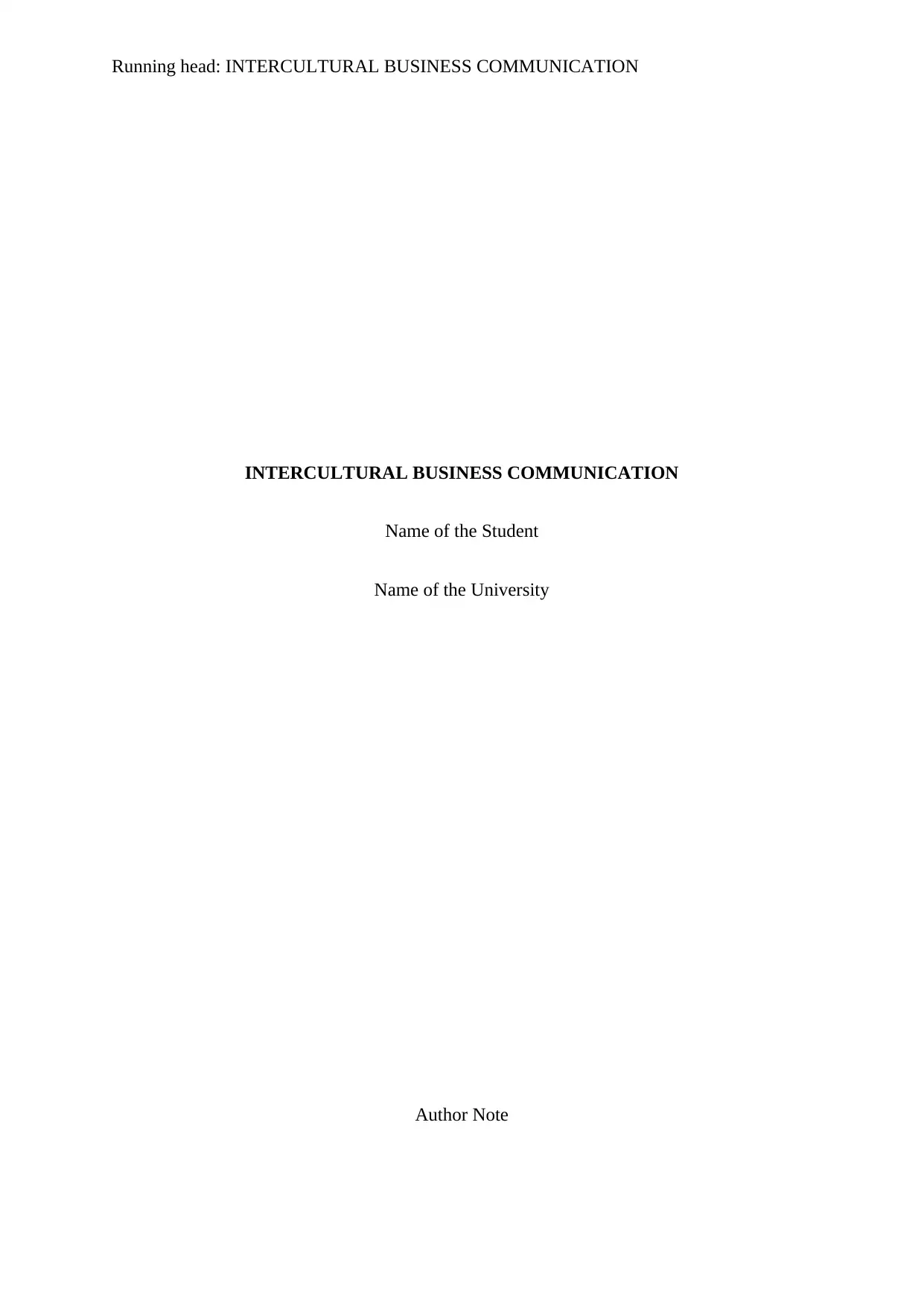
Running head: INTERCULTURAL BUSINESS COMMUNICATION
INTERCULTURAL BUSINESS COMMUNICATION
Name of the Student
Name of the University
Author Note
INTERCULTURAL BUSINESS COMMUNICATION
Name of the Student
Name of the University
Author Note
Paraphrase This Document
Need a fresh take? Get an instant paraphrase of this document with our AI Paraphraser
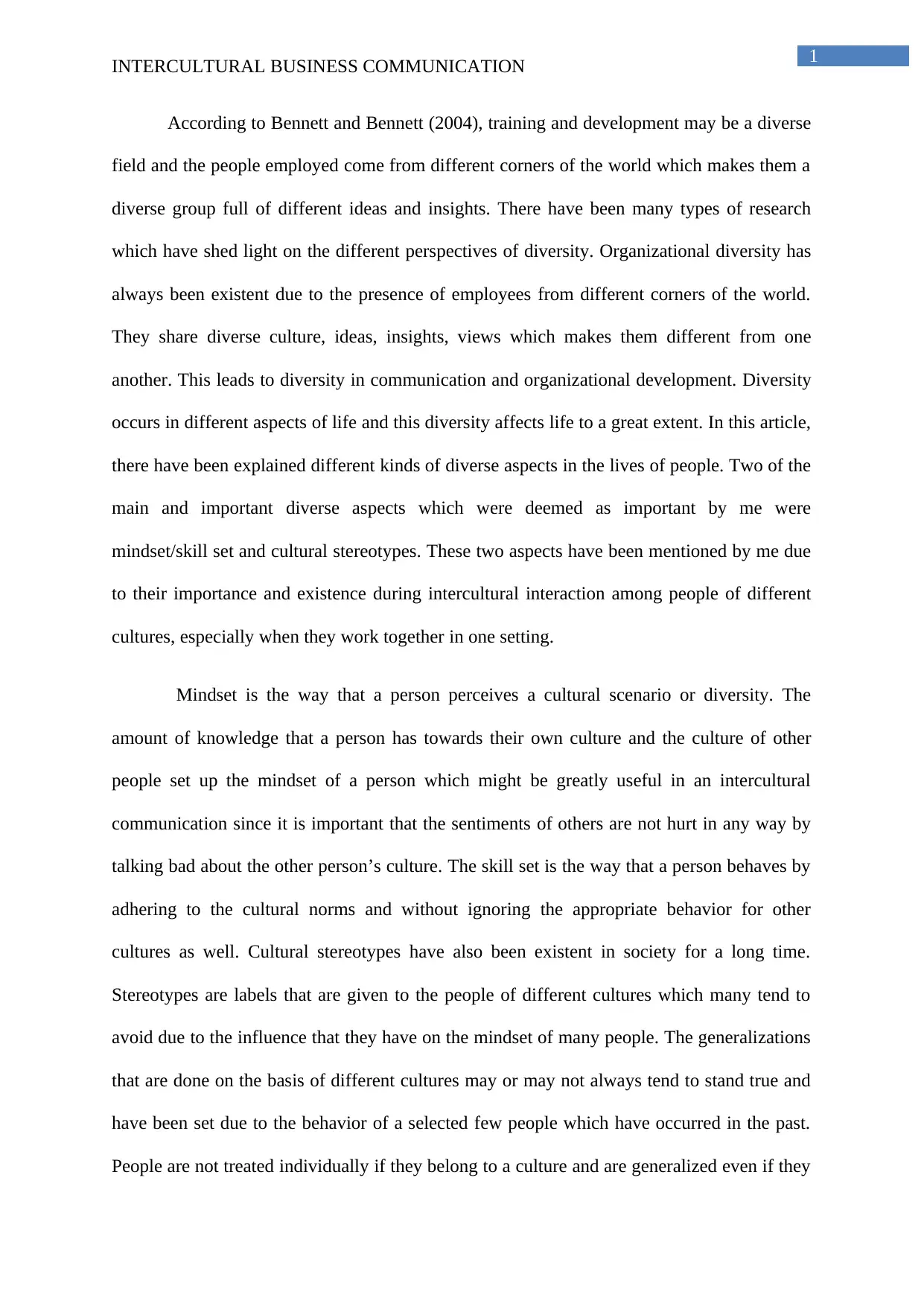
1
INTERCULTURAL BUSINESS COMMUNICATION
According to Bennett and Bennett (2004), training and development may be a diverse
field and the people employed come from different corners of the world which makes them a
diverse group full of different ideas and insights. There have been many types of research
which have shed light on the different perspectives of diversity. Organizational diversity has
always been existent due to the presence of employees from different corners of the world.
They share diverse culture, ideas, insights, views which makes them different from one
another. This leads to diversity in communication and organizational development. Diversity
occurs in different aspects of life and this diversity affects life to a great extent. In this article,
there have been explained different kinds of diverse aspects in the lives of people. Two of the
main and important diverse aspects which were deemed as important by me were
mindset/skill set and cultural stereotypes. These two aspects have been mentioned by me due
to their importance and existence during intercultural interaction among people of different
cultures, especially when they work together in one setting.
Mindset is the way that a person perceives a cultural scenario or diversity. The
amount of knowledge that a person has towards their own culture and the culture of other
people set up the mindset of a person which might be greatly useful in an intercultural
communication since it is important that the sentiments of others are not hurt in any way by
talking bad about the other person’s culture. The skill set is the way that a person behaves by
adhering to the cultural norms and without ignoring the appropriate behavior for other
cultures as well. Cultural stereotypes have also been existent in society for a long time.
Stereotypes are labels that are given to the people of different cultures which many tend to
avoid due to the influence that they have on the mindset of many people. The generalizations
that are done on the basis of different cultures may or may not always tend to stand true and
have been set due to the behavior of a selected few people which have occurred in the past.
People are not treated individually if they belong to a culture and are generalized even if they
INTERCULTURAL BUSINESS COMMUNICATION
According to Bennett and Bennett (2004), training and development may be a diverse
field and the people employed come from different corners of the world which makes them a
diverse group full of different ideas and insights. There have been many types of research
which have shed light on the different perspectives of diversity. Organizational diversity has
always been existent due to the presence of employees from different corners of the world.
They share diverse culture, ideas, insights, views which makes them different from one
another. This leads to diversity in communication and organizational development. Diversity
occurs in different aspects of life and this diversity affects life to a great extent. In this article,
there have been explained different kinds of diverse aspects in the lives of people. Two of the
main and important diverse aspects which were deemed as important by me were
mindset/skill set and cultural stereotypes. These two aspects have been mentioned by me due
to their importance and existence during intercultural interaction among people of different
cultures, especially when they work together in one setting.
Mindset is the way that a person perceives a cultural scenario or diversity. The
amount of knowledge that a person has towards their own culture and the culture of other
people set up the mindset of a person which might be greatly useful in an intercultural
communication since it is important that the sentiments of others are not hurt in any way by
talking bad about the other person’s culture. The skill set is the way that a person behaves by
adhering to the cultural norms and without ignoring the appropriate behavior for other
cultures as well. Cultural stereotypes have also been existent in society for a long time.
Stereotypes are labels that are given to the people of different cultures which many tend to
avoid due to the influence that they have on the mindset of many people. The generalizations
that are done on the basis of different cultures may or may not always tend to stand true and
have been set due to the behavior of a selected few people which have occurred in the past.
People are not treated individually if they belong to a culture and are generalized even if they
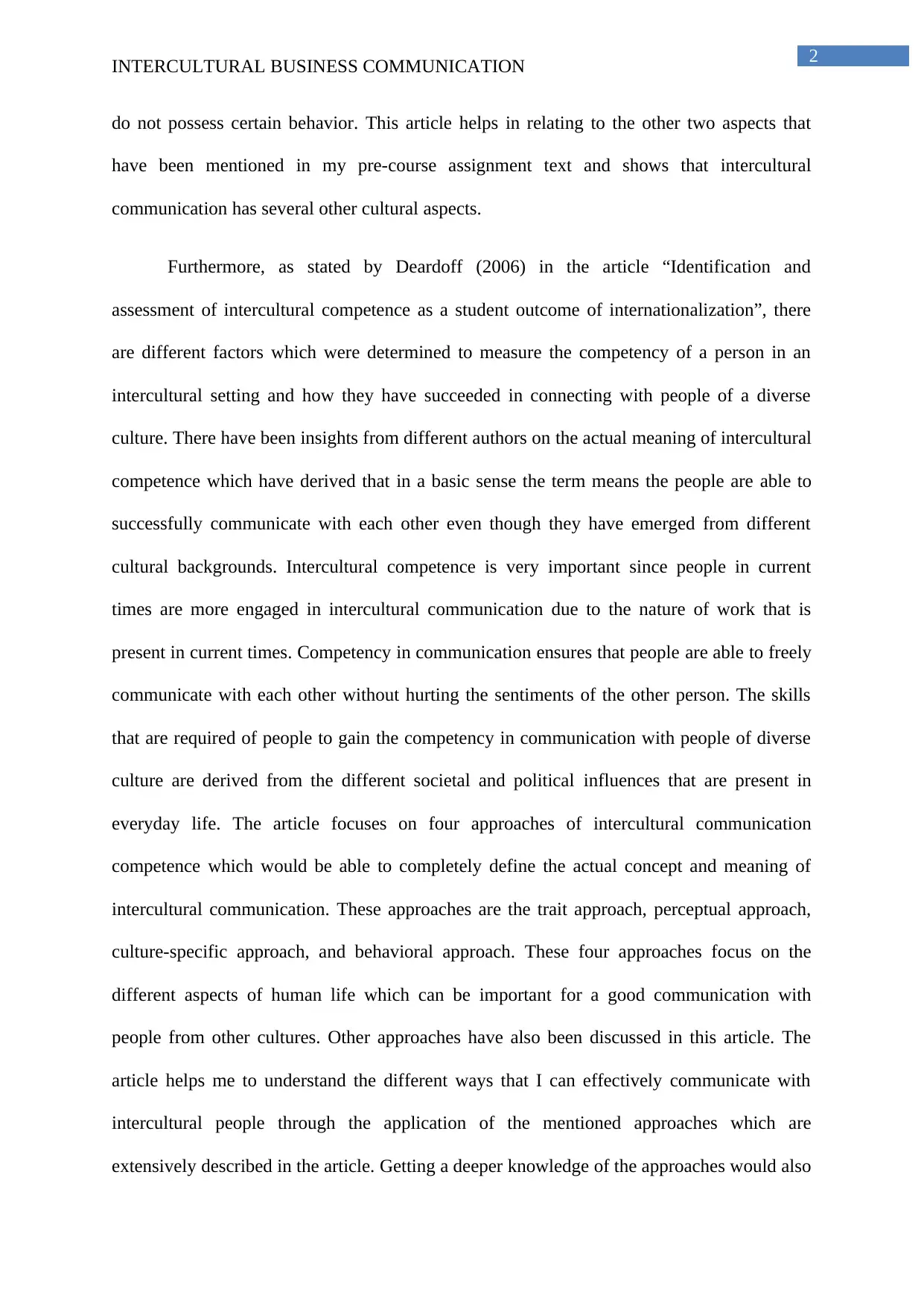
2
INTERCULTURAL BUSINESS COMMUNICATION
do not possess certain behavior. This article helps in relating to the other two aspects that
have been mentioned in my pre-course assignment text and shows that intercultural
communication has several other cultural aspects.
Furthermore, as stated by Deardoff (2006) in the article “Identification and
assessment of intercultural competence as a student outcome of internationalization”, there
are different factors which were determined to measure the competency of a person in an
intercultural setting and how they have succeeded in connecting with people of a diverse
culture. There have been insights from different authors on the actual meaning of intercultural
competence which have derived that in a basic sense the term means the people are able to
successfully communicate with each other even though they have emerged from different
cultural backgrounds. Intercultural competence is very important since people in current
times are more engaged in intercultural communication due to the nature of work that is
present in current times. Competency in communication ensures that people are able to freely
communicate with each other without hurting the sentiments of the other person. The skills
that are required of people to gain the competency in communication with people of diverse
culture are derived from the different societal and political influences that are present in
everyday life. The article focuses on four approaches of intercultural communication
competence which would be able to completely define the actual concept and meaning of
intercultural communication. These approaches are the trait approach, perceptual approach,
culture-specific approach, and behavioral approach. These four approaches focus on the
different aspects of human life which can be important for a good communication with
people from other cultures. Other approaches have also been discussed in this article. The
article helps me to understand the different ways that I can effectively communicate with
intercultural people through the application of the mentioned approaches which are
extensively described in the article. Getting a deeper knowledge of the approaches would also
INTERCULTURAL BUSINESS COMMUNICATION
do not possess certain behavior. This article helps in relating to the other two aspects that
have been mentioned in my pre-course assignment text and shows that intercultural
communication has several other cultural aspects.
Furthermore, as stated by Deardoff (2006) in the article “Identification and
assessment of intercultural competence as a student outcome of internationalization”, there
are different factors which were determined to measure the competency of a person in an
intercultural setting and how they have succeeded in connecting with people of a diverse
culture. There have been insights from different authors on the actual meaning of intercultural
competence which have derived that in a basic sense the term means the people are able to
successfully communicate with each other even though they have emerged from different
cultural backgrounds. Intercultural competence is very important since people in current
times are more engaged in intercultural communication due to the nature of work that is
present in current times. Competency in communication ensures that people are able to freely
communicate with each other without hurting the sentiments of the other person. The skills
that are required of people to gain the competency in communication with people of diverse
culture are derived from the different societal and political influences that are present in
everyday life. The article focuses on four approaches of intercultural communication
competence which would be able to completely define the actual concept and meaning of
intercultural communication. These approaches are the trait approach, perceptual approach,
culture-specific approach, and behavioral approach. These four approaches focus on the
different aspects of human life which can be important for a good communication with
people from other cultures. Other approaches have also been discussed in this article. The
article helps me to understand the different ways that I can effectively communicate with
intercultural people through the application of the mentioned approaches which are
extensively described in the article. Getting a deeper knowledge of the approaches would also
⊘ This is a preview!⊘
Do you want full access?
Subscribe today to unlock all pages.

Trusted by 1+ million students worldwide
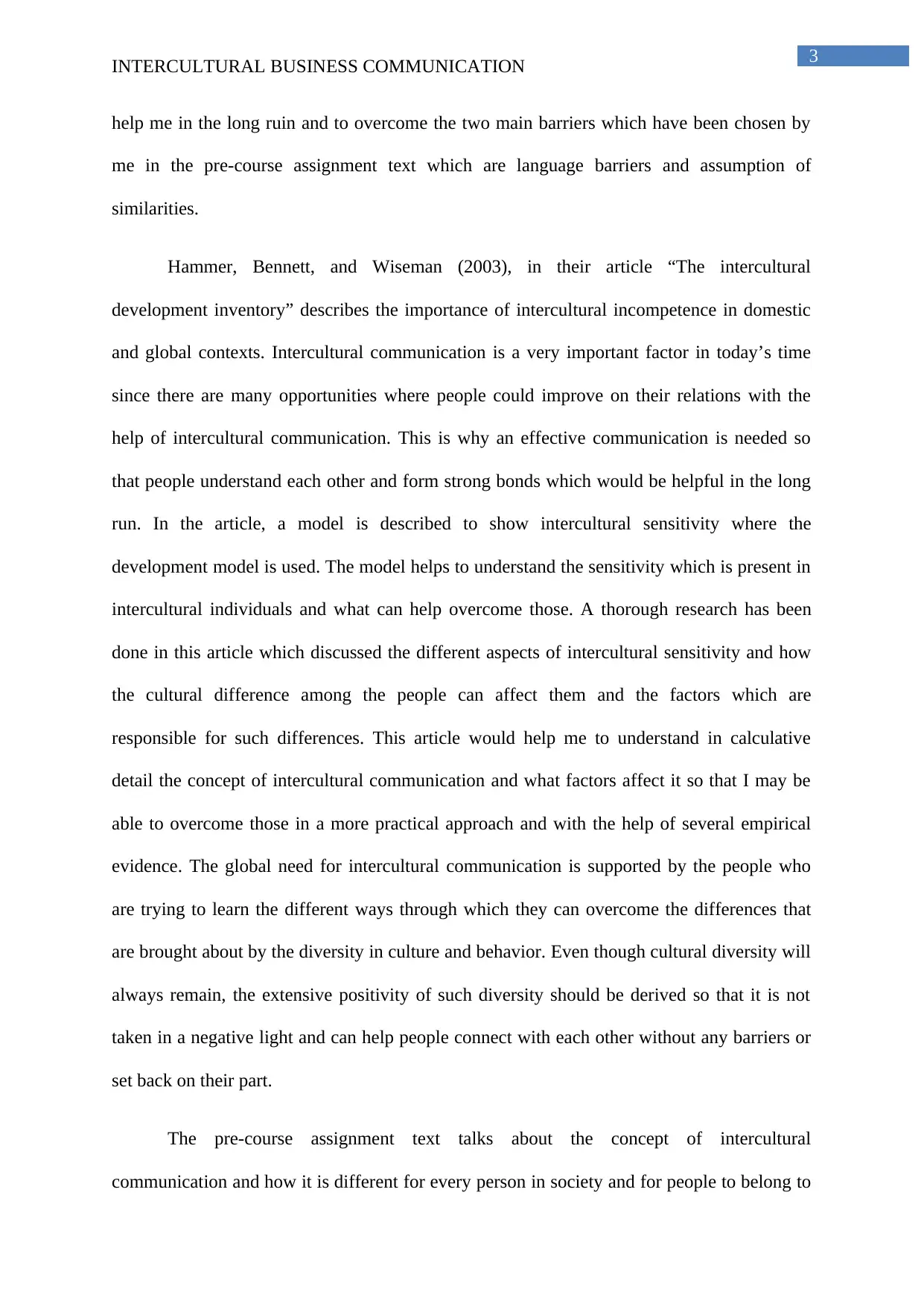
3
INTERCULTURAL BUSINESS COMMUNICATION
help me in the long ruin and to overcome the two main barriers which have been chosen by
me in the pre-course assignment text which are language barriers and assumption of
similarities.
Hammer, Bennett, and Wiseman (2003), in their article “The intercultural
development inventory” describes the importance of intercultural incompetence in domestic
and global contexts. Intercultural communication is a very important factor in today’s time
since there are many opportunities where people could improve on their relations with the
help of intercultural communication. This is why an effective communication is needed so
that people understand each other and form strong bonds which would be helpful in the long
run. In the article, a model is described to show intercultural sensitivity where the
development model is used. The model helps to understand the sensitivity which is present in
intercultural individuals and what can help overcome those. A thorough research has been
done in this article which discussed the different aspects of intercultural sensitivity and how
the cultural difference among the people can affect them and the factors which are
responsible for such differences. This article would help me to understand in calculative
detail the concept of intercultural communication and what factors affect it so that I may be
able to overcome those in a more practical approach and with the help of several empirical
evidence. The global need for intercultural communication is supported by the people who
are trying to learn the different ways through which they can overcome the differences that
are brought about by the diversity in culture and behavior. Even though cultural diversity will
always remain, the extensive positivity of such diversity should be derived so that it is not
taken in a negative light and can help people connect with each other without any barriers or
set back on their part.
The pre-course assignment text talks about the concept of intercultural
communication and how it is different for every person in society and for people to belong to
INTERCULTURAL BUSINESS COMMUNICATION
help me in the long ruin and to overcome the two main barriers which have been chosen by
me in the pre-course assignment text which are language barriers and assumption of
similarities.
Hammer, Bennett, and Wiseman (2003), in their article “The intercultural
development inventory” describes the importance of intercultural incompetence in domestic
and global contexts. Intercultural communication is a very important factor in today’s time
since there are many opportunities where people could improve on their relations with the
help of intercultural communication. This is why an effective communication is needed so
that people understand each other and form strong bonds which would be helpful in the long
run. In the article, a model is described to show intercultural sensitivity where the
development model is used. The model helps to understand the sensitivity which is present in
intercultural individuals and what can help overcome those. A thorough research has been
done in this article which discussed the different aspects of intercultural sensitivity and how
the cultural difference among the people can affect them and the factors which are
responsible for such differences. This article would help me to understand in calculative
detail the concept of intercultural communication and what factors affect it so that I may be
able to overcome those in a more practical approach and with the help of several empirical
evidence. The global need for intercultural communication is supported by the people who
are trying to learn the different ways through which they can overcome the differences that
are brought about by the diversity in culture and behavior. Even though cultural diversity will
always remain, the extensive positivity of such diversity should be derived so that it is not
taken in a negative light and can help people connect with each other without any barriers or
set back on their part.
The pre-course assignment text talks about the concept of intercultural
communication and how it is different for every person in society and for people to belong to
Paraphrase This Document
Need a fresh take? Get an instant paraphrase of this document with our AI Paraphraser
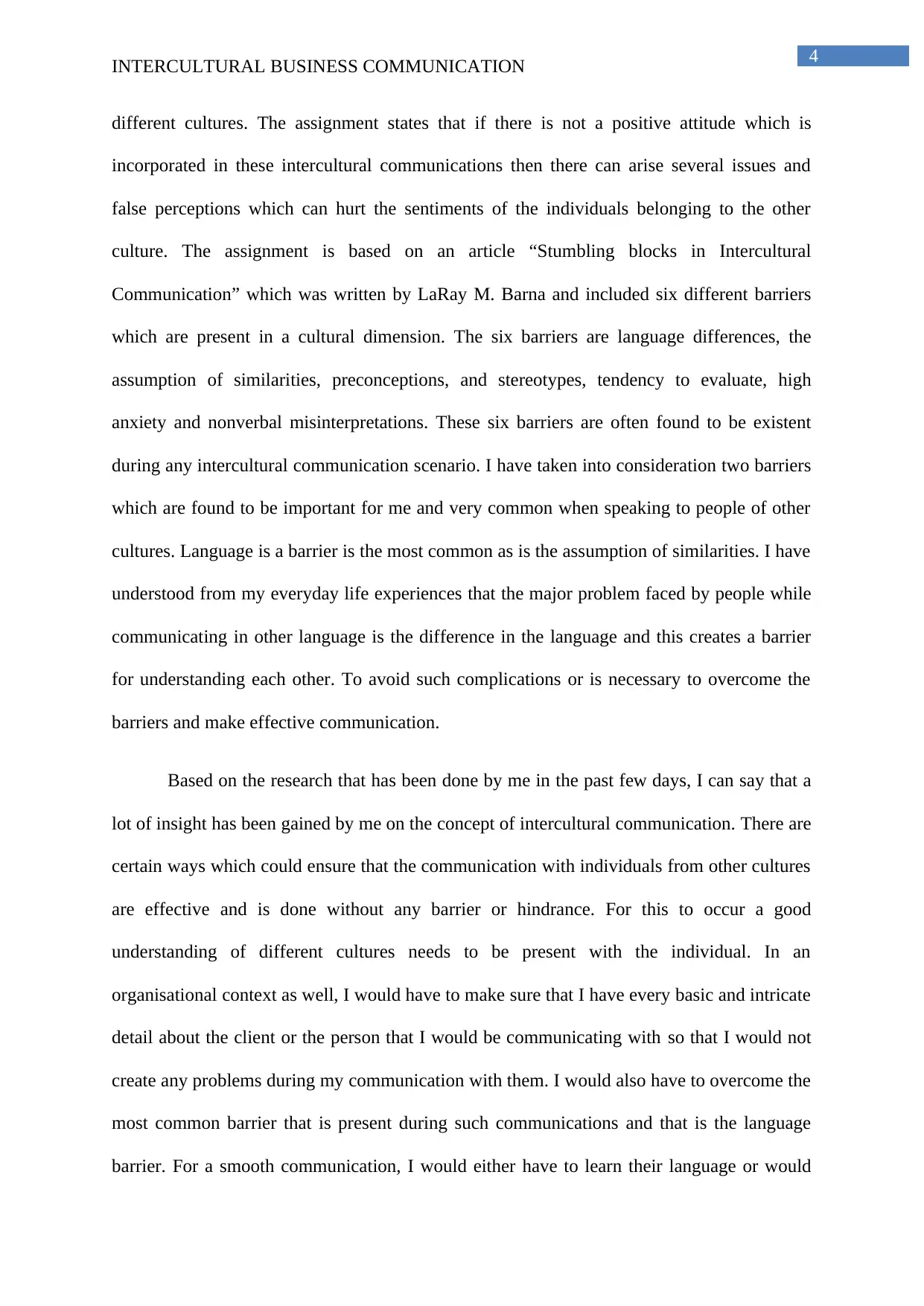
4
INTERCULTURAL BUSINESS COMMUNICATION
different cultures. The assignment states that if there is not a positive attitude which is
incorporated in these intercultural communications then there can arise several issues and
false perceptions which can hurt the sentiments of the individuals belonging to the other
culture. The assignment is based on an article “Stumbling blocks in Intercultural
Communication” which was written by LaRay M. Barna and included six different barriers
which are present in a cultural dimension. The six barriers are language differences, the
assumption of similarities, preconceptions, and stereotypes, tendency to evaluate, high
anxiety and nonverbal misinterpretations. These six barriers are often found to be existent
during any intercultural communication scenario. I have taken into consideration two barriers
which are found to be important for me and very common when speaking to people of other
cultures. Language is a barrier is the most common as is the assumption of similarities. I have
understood from my everyday life experiences that the major problem faced by people while
communicating in other language is the difference in the language and this creates a barrier
for understanding each other. To avoid such complications or is necessary to overcome the
barriers and make effective communication.
Based on the research that has been done by me in the past few days, I can say that a
lot of insight has been gained by me on the concept of intercultural communication. There are
certain ways which could ensure that the communication with individuals from other cultures
are effective and is done without any barrier or hindrance. For this to occur a good
understanding of different cultures needs to be present with the individual. In an
organisational context as well, I would have to make sure that I have every basic and intricate
detail about the client or the person that I would be communicating with so that I would not
create any problems during my communication with them. I would also have to overcome the
most common barrier that is present during such communications and that is the language
barrier. For a smooth communication, I would either have to learn their language or would
INTERCULTURAL BUSINESS COMMUNICATION
different cultures. The assignment states that if there is not a positive attitude which is
incorporated in these intercultural communications then there can arise several issues and
false perceptions which can hurt the sentiments of the individuals belonging to the other
culture. The assignment is based on an article “Stumbling blocks in Intercultural
Communication” which was written by LaRay M. Barna and included six different barriers
which are present in a cultural dimension. The six barriers are language differences, the
assumption of similarities, preconceptions, and stereotypes, tendency to evaluate, high
anxiety and nonverbal misinterpretations. These six barriers are often found to be existent
during any intercultural communication scenario. I have taken into consideration two barriers
which are found to be important for me and very common when speaking to people of other
cultures. Language is a barrier is the most common as is the assumption of similarities. I have
understood from my everyday life experiences that the major problem faced by people while
communicating in other language is the difference in the language and this creates a barrier
for understanding each other. To avoid such complications or is necessary to overcome the
barriers and make effective communication.
Based on the research that has been done by me in the past few days, I can say that a
lot of insight has been gained by me on the concept of intercultural communication. There are
certain ways which could ensure that the communication with individuals from other cultures
are effective and is done without any barrier or hindrance. For this to occur a good
understanding of different cultures needs to be present with the individual. In an
organisational context as well, I would have to make sure that I have every basic and intricate
detail about the client or the person that I would be communicating with so that I would not
create any problems during my communication with them. I would also have to overcome the
most common barrier that is present during such communications and that is the language
barrier. For a smooth communication, I would either have to learn their language or would
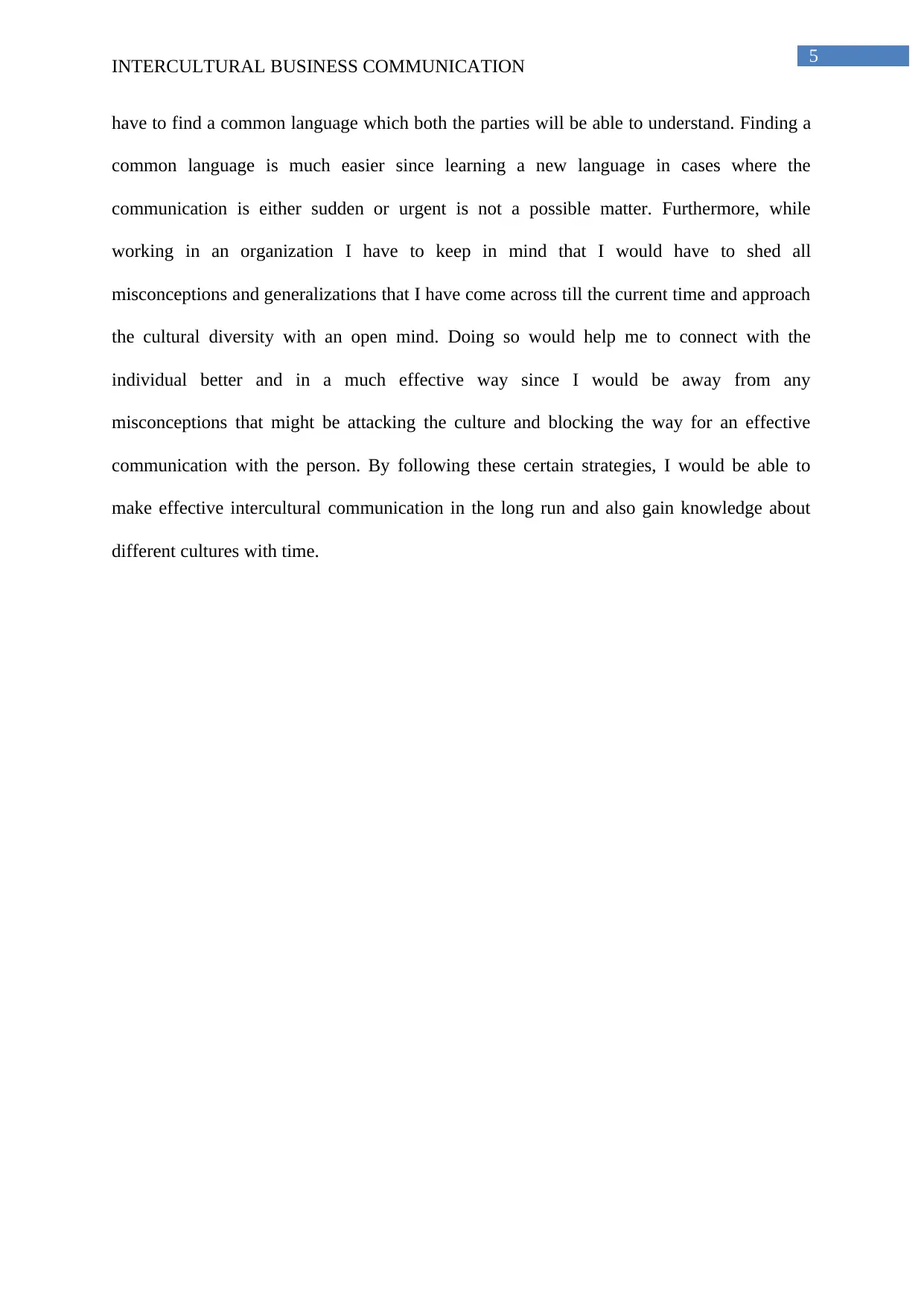
5
INTERCULTURAL BUSINESS COMMUNICATION
have to find a common language which both the parties will be able to understand. Finding a
common language is much easier since learning a new language in cases where the
communication is either sudden or urgent is not a possible matter. Furthermore, while
working in an organization I have to keep in mind that I would have to shed all
misconceptions and generalizations that I have come across till the current time and approach
the cultural diversity with an open mind. Doing so would help me to connect with the
individual better and in a much effective way since I would be away from any
misconceptions that might be attacking the culture and blocking the way for an effective
communication with the person. By following these certain strategies, I would be able to
make effective intercultural communication in the long run and also gain knowledge about
different cultures with time.
INTERCULTURAL BUSINESS COMMUNICATION
have to find a common language which both the parties will be able to understand. Finding a
common language is much easier since learning a new language in cases where the
communication is either sudden or urgent is not a possible matter. Furthermore, while
working in an organization I have to keep in mind that I would have to shed all
misconceptions and generalizations that I have come across till the current time and approach
the cultural diversity with an open mind. Doing so would help me to connect with the
individual better and in a much effective way since I would be away from any
misconceptions that might be attacking the culture and blocking the way for an effective
communication with the person. By following these certain strategies, I would be able to
make effective intercultural communication in the long run and also gain knowledge about
different cultures with time.
⊘ This is a preview!⊘
Do you want full access?
Subscribe today to unlock all pages.

Trusted by 1+ million students worldwide
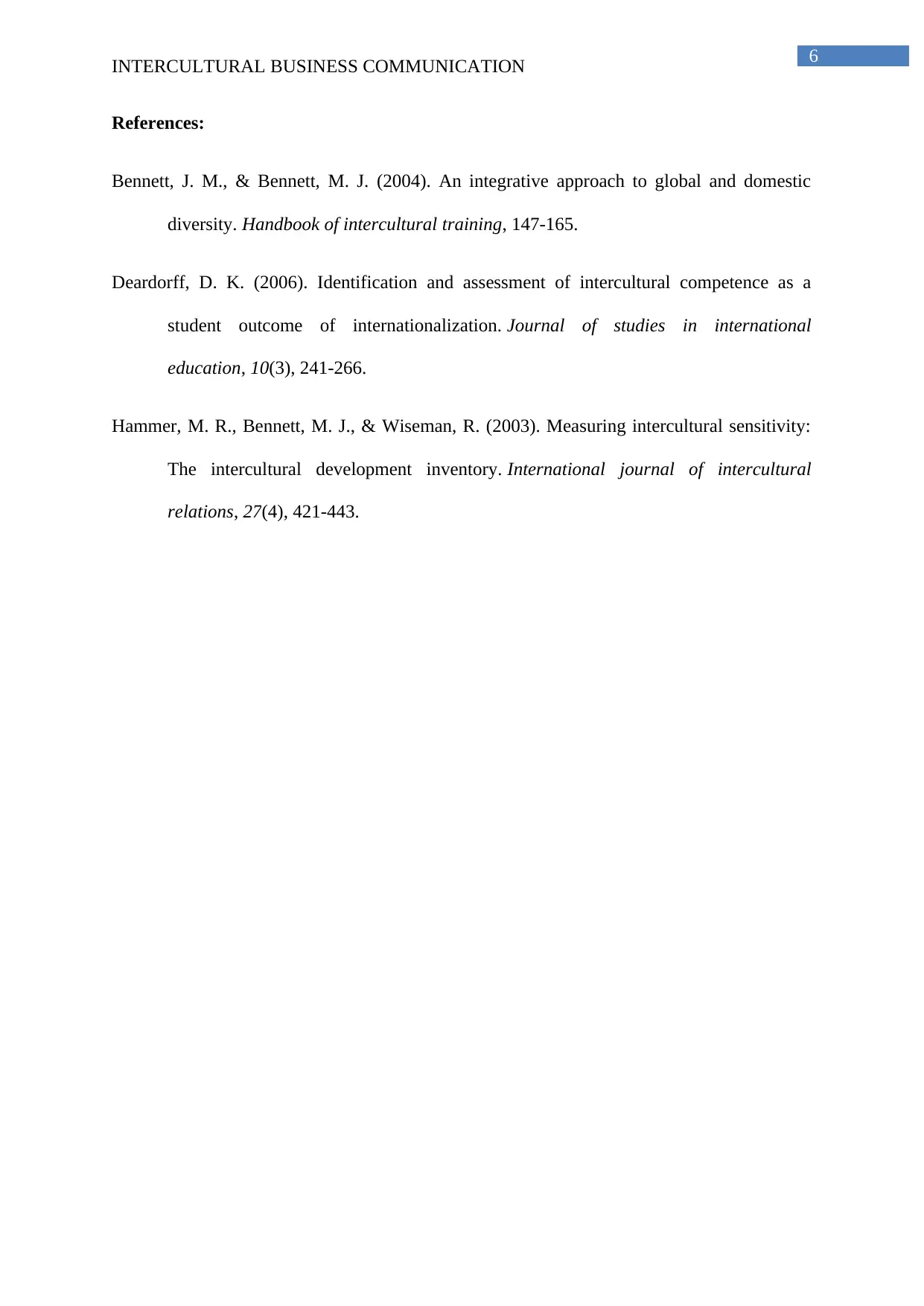
6
INTERCULTURAL BUSINESS COMMUNICATION
References:
Bennett, J. M., & Bennett, M. J. (2004). An integrative approach to global and domestic
diversity. Handbook of intercultural training, 147-165.
Deardorff, D. K. (2006). Identification and assessment of intercultural competence as a
student outcome of internationalization. Journal of studies in international
education, 10(3), 241-266.
Hammer, M. R., Bennett, M. J., & Wiseman, R. (2003). Measuring intercultural sensitivity:
The intercultural development inventory. International journal of intercultural
relations, 27(4), 421-443.
INTERCULTURAL BUSINESS COMMUNICATION
References:
Bennett, J. M., & Bennett, M. J. (2004). An integrative approach to global and domestic
diversity. Handbook of intercultural training, 147-165.
Deardorff, D. K. (2006). Identification and assessment of intercultural competence as a
student outcome of internationalization. Journal of studies in international
education, 10(3), 241-266.
Hammer, M. R., Bennett, M. J., & Wiseman, R. (2003). Measuring intercultural sensitivity:
The intercultural development inventory. International journal of intercultural
relations, 27(4), 421-443.
1 out of 7
Related Documents
Your All-in-One AI-Powered Toolkit for Academic Success.
+13062052269
info@desklib.com
Available 24*7 on WhatsApp / Email
![[object Object]](/_next/static/media/star-bottom.7253800d.svg)
Unlock your academic potential
Copyright © 2020–2025 A2Z Services. All Rights Reserved. Developed and managed by ZUCOL.





